Last weekend, a group of Umbra students departed for Sicily on the first optional weekend trip of the semester. After an early morning flight to Catania, the group arrived at their hotel in Giardini di Naxos, on the eastern coast of Sicily.
Throughout the weekend, students toured several coastal cities – the lava city of Catania, archeological remains in Siracusa, the chic coastal town of Taormina, and fishing villages Acitrezza and Acicastello.
The Umbra weekend trips are planned so that students tour nearby cities during the day and return to their hotel in the afternoon for dinner and free time to explore Sicily on their own. For many students, the afternoons were spent walking the beach and watching the sun set behind Mount Etna in the distance.
“Sicily is breathtaking,” said Alex Chartrand, a student from the University of Missouri. “Many of us were just happy to be in the sun, to walk the beaches, and to explore the little towns.” It wasn’t only the natural beauty of Sicily which attracted students, but also the local cuisine. Sicily’s famous granite (the original Italian ice), ricotta-filled cannoli, and arancine (fried rice balls filled with mozzerella cheese) tempted the crowd.
The next optional weekend trip is scheduled for April 7-9 when a group from Umbra will head south again to Naples, Sorrento, Pompeii, and Capri.
In photos: the main piazza of Taormina, a fisherman on the rocks in Acitrezza, the beach of Giardini di Naxos in front of the hotel, and a guided tour of the ruins in Siracusa.




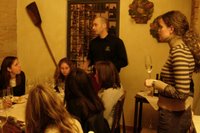
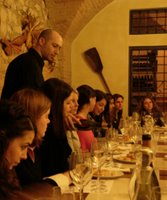 the north of Italy. Manna from the vineyard Franz Haas in Alto Adige was a light-bodied white that can be paired with poultry dishes. Manna was also a 2004 IGT wine. To finish up, students tasted a red wine from Puglia, in the south of Italy. The Negramaro Cantalupi from Conti Zecca was a unique wine in that, the grapes used to create the wine, negramaro grapes, are found only in Puglia. A smooth red wine, the Negramaro Cantalupi would compliment meat dishes.
the north of Italy. Manna from the vineyard Franz Haas in Alto Adige was a light-bodied white that can be paired with poultry dishes. Manna was also a 2004 IGT wine. To finish up, students tasted a red wine from Puglia, in the south of Italy. The Negramaro Cantalupi from Conti Zecca was a unique wine in that, the grapes used to create the wine, negramaro grapes, are found only in Puglia. A smooth red wine, the Negramaro Cantalupi would compliment meat dishes. 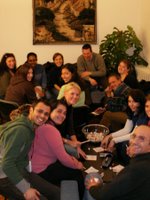
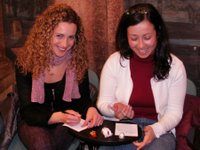
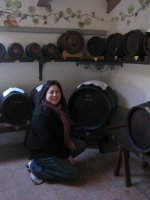 I’ve been on since I arrived in Italy in September. Witnessing the making of balsamic vinegar and Parmigiano-Reggiano cheese was not only interesting, but allowed me to learn about foods that I eat daily. The balsamic vinegar “farm” was actually situated in a family home in Modena, Italy, where this particular family made the infamous Aceto Balsamico Traditionale di Modena. Here, fermentation occurs during the summer in wooden barrels, each with a different wood providing a distinct flavor.”
I’ve been on since I arrived in Italy in September. Witnessing the making of balsamic vinegar and Parmigiano-Reggiano cheese was not only interesting, but allowed me to learn about foods that I eat daily. The balsamic vinegar “farm” was actually situated in a family home in Modena, Italy, where this particular family made the infamous Aceto Balsamico Traditionale di Modena. Here, fermentation occurs during the summer in wooden barrels, each with a different wood providing a distinct flavor.” mixing and heating, the mixture begins to curdle naturally and the cheese is cut into two pieces and strained through cheesecloth. The leftover liquid is centrifuged to remove any cream and fed to pigs nearby (which is why proscuitto di parma tastes so good!). Each cheese spends one day in a wooden molding, one day in a steel molding, a month in a salt-water bath, and finally two or more years in the warehouse.”
mixing and heating, the mixture begins to curdle naturally and the cheese is cut into two pieces and strained through cheesecloth. The leftover liquid is centrifuged to remove any cream and fed to pigs nearby (which is why proscuitto di parma tastes so good!). Each cheese spends one day in a wooden molding, one day in a steel molding, a month in a salt-water bath, and finally two or more years in the warehouse.” After the first month of intensive Italian language classes, it was encouraging to see such a large group of students appear for the first Tandem language exhange activity. More than 60 students – both Italians and Americans – gathered for icebreaking exercises and activities. Mauro Renna, student services associate and coordinator of the Tandem program, was excited to see so many students and to hear that many of them had made plans outside of the program with other Italian students.
After the first month of intensive Italian language classes, it was encouraging to see such a large group of students appear for the first Tandem language exhange activity. More than 60 students – both Italians and Americans – gathered for icebreaking exercises and activities. Mauro Renna, student services associate and coordinator of the Tandem program, was excited to see so many students and to hear that many of them had made plans outside of the program with other Italian students.
